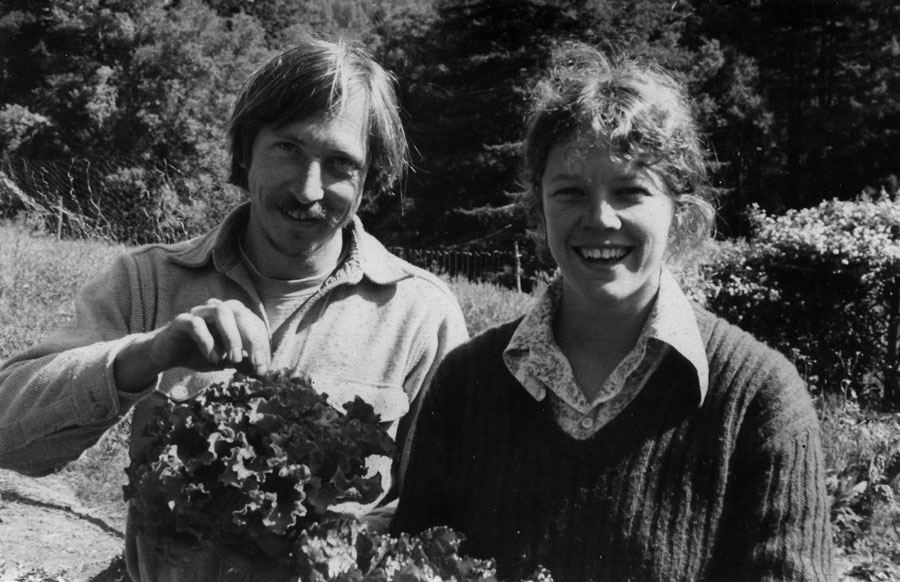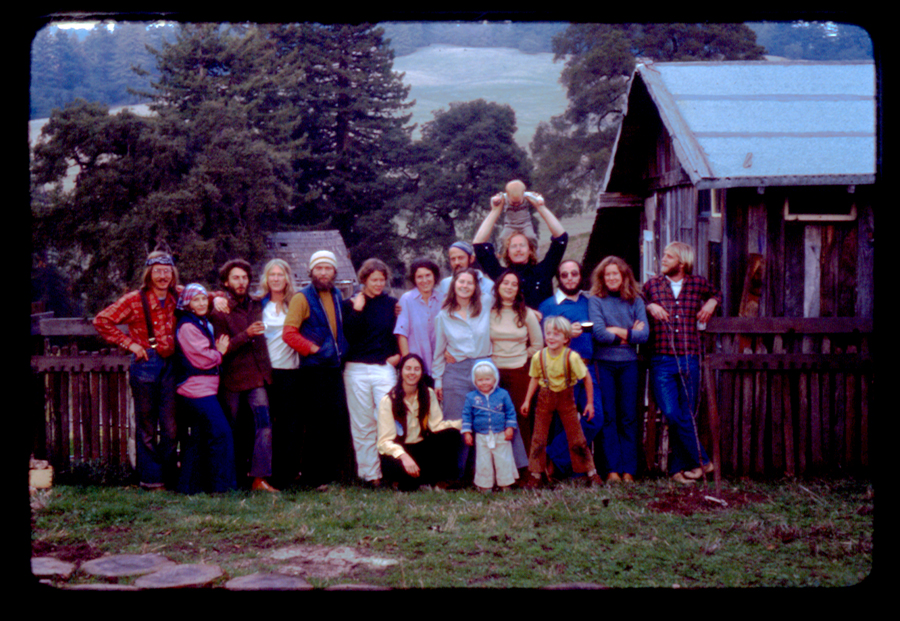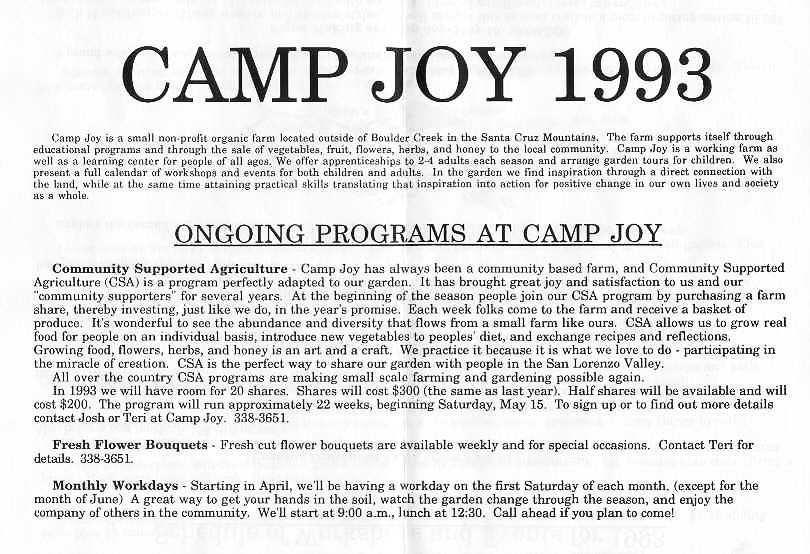Jim Nelson Remembers Alan Chadwick
Jim Nelson worked with Alan Chadwick in the first years of the Santa Cruz garden. He had been a student, but very soon after meeting Alan, decided to take a leave of absence from the University in order to work full-time in the garden. It was there that he met his future wife, Beth Benjamin. Together they became pillars of support for Chadwick in his efforts to demonstrate the efficacy of organic methods of farming and gardening at UCSC.

Jim Nelson and Beth Benjamin at Camp Joy
Several years later, Alan received a letter from someone inquiring if any of his apprentices would be interested in developing a garden on a parcel of land located in Boulder Creek. He immediately thought of Jim and Beth, who contacted the owner and quickly agreed to undertake the project at what would later come to be called "Camp Joy." Several other intrepid gardeners joined the project, including Michael Stusser, who later directed the film "Garden" that appears elsewhere on this website.

The crew at Camp Joy in the year 1979. Jim Nelson (far left); Michael Stusser (third from left); Beth Benjamin (sixth from left);
On October 11, 2017, Jim Nelson was interviewed at his Camp Joy studio by Greg Haynes. In a very lively way, he tells about his experiences with Alan Chadwick during the early years of the garden. He describes an important conversation that he had with Jasper Rose, an art history professor at UCSC who was himself a regular at lunch and tea times in the garden. Jim also mentions Paige Smith, the first provost of Cowell College, who advocated the establishment of agricultural projects for youth that would constitute "the moral equivalent of war." Jim here repeats the anecdote that he recently told at the 50th year celebration of the beginning of Chadwick's work at UCSC, about overhearing Alan speaking aloud to the fir trees about the qualities of the University of California at Santa Cruz. There is much more of interest in this two-part interview.
Part 1 of Jim Nelson's interview about his experiences with Alan Chadwick
Part 2 of Jim Nelson's interview about his experiences with Alan Chadwick
Camp Joy has endured these many years as a non-profit educational organization teaching some of the methods that Chadwick introduced fifty years ago at UCSC. Even today the place is bustling with life. Apprentices can be found weaving dried flowers into wreaths, collecting eggs, cutting flowers, and attending to all the other chores that are part of a working farm. Below are portions of the Camp Joy Newsletter from the year 1993:


The following is an excerpt from an extensive interview with Jim Nelson by the Oral History Project at the University of California at Santa Cruz, conducted on August 20, 2008. The direct link is located here: http://digitalcollections.ucsc.edu/cdm/compoundobject/collection/p15130coll2/id/206
The Inception of the Chadwick Garden
There’s an interesting story of how the Garden Project at UCSC came to be. I always try to tell this story to new apprentices. For years I‘ve told this story. I heard this story twice from Alan, and both times during turbulent times when it looked like the Garden wouldn’t continue, for one reason or another. He would reach deep, and tell us why he was there and how he’d come to be there. I also heard Page Smith tell this story. It was in the very early years of the university. The university was two or three years old. And at that point in time, the concept of UC Santa Cruz included a lot of innovations, a new idea of cluster colleges each with its own major emphasis, a liberal arts kind of model. Page Smith was really central to the whole thing,
Page Smith was very important in all this happening. And there was a poetry professor named Donald Nicholl from England who was there initially. He was a writer and had a reputation. Norman O. Brown was there. Norman actually talked about that too, at the twenty-fifth reunion. He talked about the origins from his point of view, of the Chadwick Garden and how it was innovative and everything. He wasn’t really a central player in its coming about. He was there and then wrote about it.
Donald Nicholl gave a talk. The name of his talk, I believe, was “A Sense of Place.” Now that’s a pretty well-known phrase, but I have the sense that that was just being coined, that sense of a sense of place. I wasn’t there for the talk, but he gave it. And there was a concern about the relationship between this growing university complex on the Cowell lands that it had acquired, and the history of the Cowell lands, and the history of the Native Americans. There was a concern about how this university was going to maintain its sense of place. The connection with the uniqueness of the land, I think, was what brought up that very question. If it had just been in the middle of Modesto or something— Of course, it would still be relevant as to how does this fit into the Central Valley agriculture. But it had to do with how does [the university] fit into this beautiful forest land on the marine terraces.
Donald Nicholl had given talks about a poet named David Jones. David Jones was an English poet, who, in the form of an epic, had written a story about reconstruction after the devastation of the Second World War. And in this epic, there was an image of a man coming to plant gardens. So that was wound into his sensitivity and probably was mentioned in the talk. At the end of the talk somebody asked, “Well, how can we develop this sense of place here?” (I think maybe his talk was on a sense of place in a bigger context, and wasn’t necessarily applied to the university. Maybe it came out of the questions.) And he laughed and said, “Well, there are three ways—and I always say that when somebody asks me a question, because it gives me a little more time to think.”
And the third one was: plant a garden. In the audience listening to this talk was Page [Smith], of course, and Paul Lee, and also a woman named Freya von Moltke, who was living with and taking care of a very prestigious professor named Eugen Rosenstock-Huessy. He had been one of Page Smith’s mentor professors at Dartmouth. He was a German Jewish man who had fled Germany during the rise of Nazism and Hitler. He was a religious person at a time when there was a lot of academic, intellectual conflict between science and religion. Rosenstock-Huessy tried to keep them together and openly spoke of his religious faith and spiritualism, and was a voice of that. So he was in the audience.
After this talk, there was this dialog that developed. An idea came up of starting a garden, a student garden. So then Freya von Moltke said— Well, going back in time, the fact that she was there was auspicious, because her husband, the Count [Helmuth James] von Moltke was also a German man who was involved in politics and religion in Germany and had connections with Steiner and those people in Germany. And he didn’t flee the country. He stayed and tried to oppose the rise of Hitler and eventually was arrested and implicated in a plot to assassinate Hitler, and imprisoned and tried, and got to speak about God and this whole conflict [of science and religion] in the trial, which was apparently very meaningful to him. But he was eventually executed by Hitler. And in the last months of his life the only person that was able to see him was this [prison] chaplain, who then communicated back and forth to his wife [Freya]. And one of his last wishes to his wife was that, “I see this great shadow, this darkness coming. And when it eventually passes, go somewhere, find somewhere in the world where you can start a garden, where young people will learn of creation, because there’s so much destruction in the world.”
She held that wish in her mind until 1967. And then Don Nicholl [was] talking about a garden, and a sense of place. All of a sudden they were talking about a garden. So she said, “Well, I know the perfect man to start this garden.” Alan Chadwick had been a longtime friend of hers. They had spent time together in South Africa in relation to classical drama, and the British Admiralty Gardens, which Alan ran. I found out more recently that Alan had mentored her two sons.
Because of his ability to connect with people and find out what they’re thinking, he had inspired her two sons in some significant way that made her realize that he had that quality in him. And she knew that he was a consummate gardener and was committed to his vision of beauty and health, and maybe organics. So she wrote him a letter and asked him to come and start this garden.
Then of course the stories that I heard from Alan, and maybe through Page, was that when Alan came he was skeptical because he saw the university as a place dedicated to science and serving industry. It wasn’t serving a vision of wholeness and beauty. He said something about: “This university is a place of science and destruction.” If that statement got around, then you can kind of understand why people didn’t like Alan, some of the people. There was some truth in that, but it was kind of a pretty black-and-white statement. But she said, “No, no. Wait until I get there. I think this is the right place,” I think probably because she knew this handful of inspired professors, and the vision of innovation of the campus. So she said, “I know it will be very difficult. It will be an uphill struggle. But if we succeed, it will endure.”
So that’s how he came. Alan had so much will and charisma and force in his character. Who knows? I don’t know if it would have taken if it hadn’t been somebody like him with that much personal power and commitment and vision.
Alan told that story probably to reinvigorate his own commitment to it, and ours, because both times he told this story the garden’s future was uncertain. One time was when they were going to take away the whole nursery garden for a provost’s house and we were trying to decide whether to move the whole garden.
That [story] links it back into history, and it links it into this human struggle to develop a more right way of living on the planet. That’s a pretty interesting story, and I always love to tell that story to the current apprentices.
[editor's note: In contrast to some of the other interviews on the history of the UCSC Garden and Farm project, this interview with Jim Nelson stands out as an example of Oral History at its best. Jim's answers are even-tempered and objective. He definitely aludes to some of Alan Chadwick's eccentricities and the challenging aspects of what it meant to work with him at that time, but these are balanced with Alan's many positive attributes. The result is a very accurate and compelling story of the man, Alan Chadwick, and the times that he lived in there at Santa Cruz, California, in the late 1960's.]
